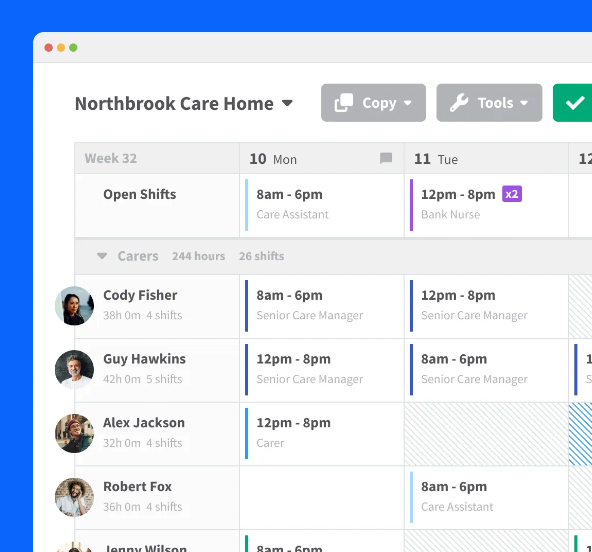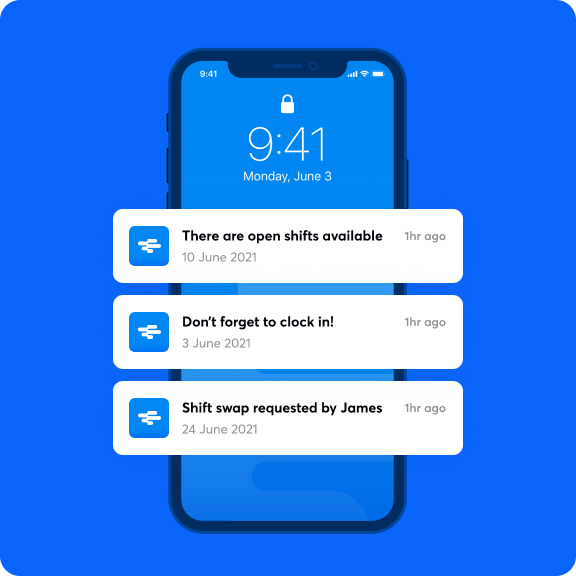Updated: 18.04.24
Whether it involves night shifts, long hours, or simply a rota that changes every week, shift-based workers are particularly vulnerable to stress — stress that can lead to all manner of physical and mental health problems if left unchecked.
With this in mind, we’ve prepared a collection of actionable tips for managers and business owners to help reduce stress for shift-based staff, much of which focuses on our particular area of expertise: staff scheduling.
Let's get straight to it.
1. Provide a consistent employee experience
2. Invite input from staff before scheduling shifts
3. Choose a shift pattern that gives staff time to recuperate
4. Let staff arrange their own cover when they’re feeling overwhelmed
5. Create a healthy culture around taking time off
1. Provide a consistent employee experience
When it comes to our mental health, the importance of routine cannot be underestimated. In fact, research shows that patterns and predictability in our everyday lives are not just good for us, but actually make us happier and more productive.
You can’t do much to prevent unexpected events and disruptions occurring in your staff’s home-lives, but you do have a role to play in creating an employee experience that’s as consistent, smooth, and stress-free as possible.
There are a number of ways you can achieve this:
- Make work rotas available in advance. Staff who have more notice of their shifts are better able to organise events in their personal lives, and are less likely to feel stressed. Managers should aim to provide their team with their rota at least seven days ahead of the first shift.
- Release the rota at the same time each week/month. In addition to sharing the rota early, staff should know when they can expect to receive their schedule by — not least so they don’t have to pester their manager, asking if it’s ready.
- Keep the rota visible. The work rota should be kept up to date and be accessible to your team 24/7. Your staff shouldn’t have to come into work or call up to double-check when they’re working.
- Communicate changes right away. Changes happen, but there are few things more annoying for staff than arriving at work only to find that their shift is three hours longer than they expected or has been cancelled entirely.
- Choose a payday (and stick to it). Money can be a major source of stress and anxiety for many. Help your employees manage their finances by deciding a regular payday (or paydays), sticking to it, and ensuring that funds reach accounts by a set time.

Streamline scheduling & boost communication
✅ Plan and share rotas in minutes, not hours.
✅️ Keep staff in the loop with automatic shift updates.
✅ Free mobile app lets staff check their rota whenever they like.
2. Invite input from staff before scheduling shifts
Work rotas are usually very prescriptive affairs. Apart from things like sickness or booked leave, staff tend to work the shifts they’re given and have little say over when they’ll be in.
The reason for this, more often than not, is simply time constraints on the part of the manager. As much as they might like to build rotas that take their staff’s personal commitments and circumstances into consideration, few managers have the time or resources required to do so.
The feeling of having little or no control over one’s work-life can be a major stressor, however — especially when we consider how much of our lives are spent at work.
But this is where technology can help. By using software that allows staff to quickly and easily communicate their working availability — and for that availability to be visible to you as you build the rota in real time — you no longer have to keep track of the shifts staff can and can’t work, and can more easily produce a schedule that works for everyone.
The upshot of this (in addition to giving your staff the shifts they prefer!) is that your team are less likely to come to you asking for alterations after the rota has been published, cutting down on admin and reducing confusion for everybody.
3. Choose a shift pattern that gives staff time to recuperate
You’ll know your business better than anyone else, and will understand which shifts need the most staff and where. But care should be taken when choosing shift patterns, factoring in not just the level of cover they facilitate, but the effect they’ll have on the staff filling those roles.
Need to provide 24-hour cover? A 3-shift pattern (where staff take turns working mornings, afternoons, or night shifts) might be better — and fairer — than having the same people always working the more unsociable hours.
If you have staff who work nights, a “DuPont” shift pattern (where staff receive a full seven days off after working alternate day/night shifts for a period of 21 days) could be a better fit, and allow staff to spend time with their friends and family, which is thought to help reduce stress and increase feelings of happiness.
Explore different shift patterns and try to measure their impact on things like employee engagement, fatigue, and productivity over time. No one size fits all when it comes to staff rotas, so be wary of mimicking others or using the exact same shift patterns for different roles or departments within your business.

4. Let staff arrange their own cover when they’re feeling overwhelmed
When things start piling up and mental health is beginning to suffer, the last thing someone might want to do is head into work for a busy, 10-hour shift.
Few managers would force a member of staff who they know is feeling overwhelmed to come in, but when the onus is on them to find cover — typically ringing around the team and frantically scribbling things out on the rota — it can be a difficult situation to put right.
A simple solution to this is to use scheduling software that enables staff to organise cover or shift swaps with other members of the team instead of leaving this task to their manager.
Platforms like RotaCloud let staff propose swaps with eligible (i.e. those who aren't already working, and who are qualified to work the role) team members via the employee mobile app, before sending this proposal to their manager to approve or deny with the push of a button.
Not only does this save managers the hassle of filling gaps in the rota, but it gives staff a much greater feeling of control over their work lives — and eliminates the feelings of guilt that can sometimes come about when calling in sick or telling their employer that they don’t feel up to working.

Give your staff the tools they need
RotaCloud lets staff arrange cover and shift swaps via their mobile phones — all you have to do is click 'Approve' or 'Deny'.
5. Create a healthy culture around taking time off
It might seem counterproductive to encourage your staff to take time off when you’ve got a business to run — especially if you work in an industry that’s suffering from severe staff shortages.
But research shows that, together with lower productivity when they’re at work, staff who don’t make full use of their entitled annual leave are more likely to fall ill or exhibit signs of stress than those who do.
As part of your effort to create a positive, streamlined employee experience, be sure to make the booking and taking of annual leave a top priority to help reduce stress for shift-based workers.
Here's how to do it:
- Establish a system for booking holiday. Whether it’s by filling in a form, emailing their supervisor, or via a dedicated people management app, staff should have an easy process for requesting time off.
- Encourage taking time off. Staff should be reminded of the importance of taking time off, and provisions put in place (e.g. advanced shift scheduling) to prevent understaffing and feelings of guilt surrounding taking annual leave.
- Keep leave allowances visible. Staff should know how many days off they’re entitled to, and should be able to check on this without having to ask you.
- Process leave requests promptly. You might not be able to honour every holiday request that comes in, but be sure to respond to each one promptly so that staff can make plans in advance. Don’t leave anyone hanging when they’re taking action to prioritise their mental health.
Special consideration should also be taken to staff who accrue their holiday over time rather than having a whole block of days to get through.
Staff scheduling software that automatically records employees’ holiday allowance based on the shifts they work can make this process far easier — saving you the hassle of manually logging shift data, and allowing staff to check their allowances whenever they like.
Wrap-up
On the surface, stress might seem like an inevitable consequence of shift work. Constantly changing schedules, early starts, late finishes, and unsociable hours can easily result in staff feeling mentally and physically drained before too long.
But it doesn't have to be this way.
By creating a working environment that empowers staff — by giving them a degree of control and ownership over their shifts, together with 24/7 access to and advance notice of their schedule — staff are much less likely to feel that their lives are completely governed by external factors.
Implementing changes like these doesn't only benefit staff, however. By inviting staff to communicate their availability for shifts and encouraging advance booking of annual leave, staff are less likely to request last-minute changes to the rota, fall ill due to burnout, or show up late for shifts.






